HUCL1101: Workplace Cultural Diversity in a Japanese Health Org.
VerifiedAdded on 2022/08/17
|10
|1298
|9
Report
AI Summary
This report analyzes the multifaceted aspects of cultural diversity within the Japanese workplace, with a specific focus on its implications for health organizations. The study explores key factors such as the influence of cultural values on health concepts, highlighting the interplay between individual perceptions of health and illness. It examines the impact of family patterns and gender dynamics, particularly the traditional patriarchal structure, on workplace interactions and patient preferences. Communication is identified as a critical element, emphasizing the importance of empathetic and clear interactions, especially with immigrants. The report also addresses the significance of understanding death and dying practices in Japanese culture to enhance caregiver-patient relationships. The conclusion underscores the importance of these elements in shaping cultural diversity and its influence on the health professionals' mindset and the healthcare services provided. The report also references relevant academic research and provides a statistical representation of the effect of gender diversity in Japan.

Running head: CULTURAL DIVERSITY
Cultural Diversity at the Workplace in Japan
Name of the Student
Name of the University
Author Note
Cultural Diversity at the Workplace in Japan
Name of the Student
Name of the University
Author Note
Paraphrase This Document
Need a fresh take? Get an instant paraphrase of this document with our AI Paraphraser

1CULTURAL DIVERSITY
Cultural Diversity at the Workplace in Japan
With the increasing rates of globalization, Cultural diversity at the workplace has been a
significant trend in recent times. As the term suggests, It refers to the variation in terms of
different aspects such as ethnicity, nationality, language as well as religion, which results in
divergence among the employees in the workplace(Hamamura, 2017). The employees belonging
to various cultural or ethnic backgrounds, when working together and are correlated
professionally, impart either a positive or a negative influence on the work environment.Also, the
impact widens when the designated workplace is a health orgaisation. Thus, this study will
address the predominant influencing factors which affect the alterations and deviations between
the professionals of a different cultural setup, through an illustrative link with a Japanese health
organization
Cultural Diversity at the Workplace in Japan
With the increasing rates of globalization, Cultural diversity at the workplace has been a
significant trend in recent times. As the term suggests, It refers to the variation in terms of
different aspects such as ethnicity, nationality, language as well as religion, which results in
divergence among the employees in the workplace(Hamamura, 2017). The employees belonging
to various cultural or ethnic backgrounds, when working together and are correlated
professionally, impart either a positive or a negative influence on the work environment.Also, the
impact widens when the designated workplace is a health orgaisation. Thus, this study will
address the predominant influencing factors which affect the alterations and deviations between
the professionals of a different cultural setup, through an illustrative link with a Japanese health
organization
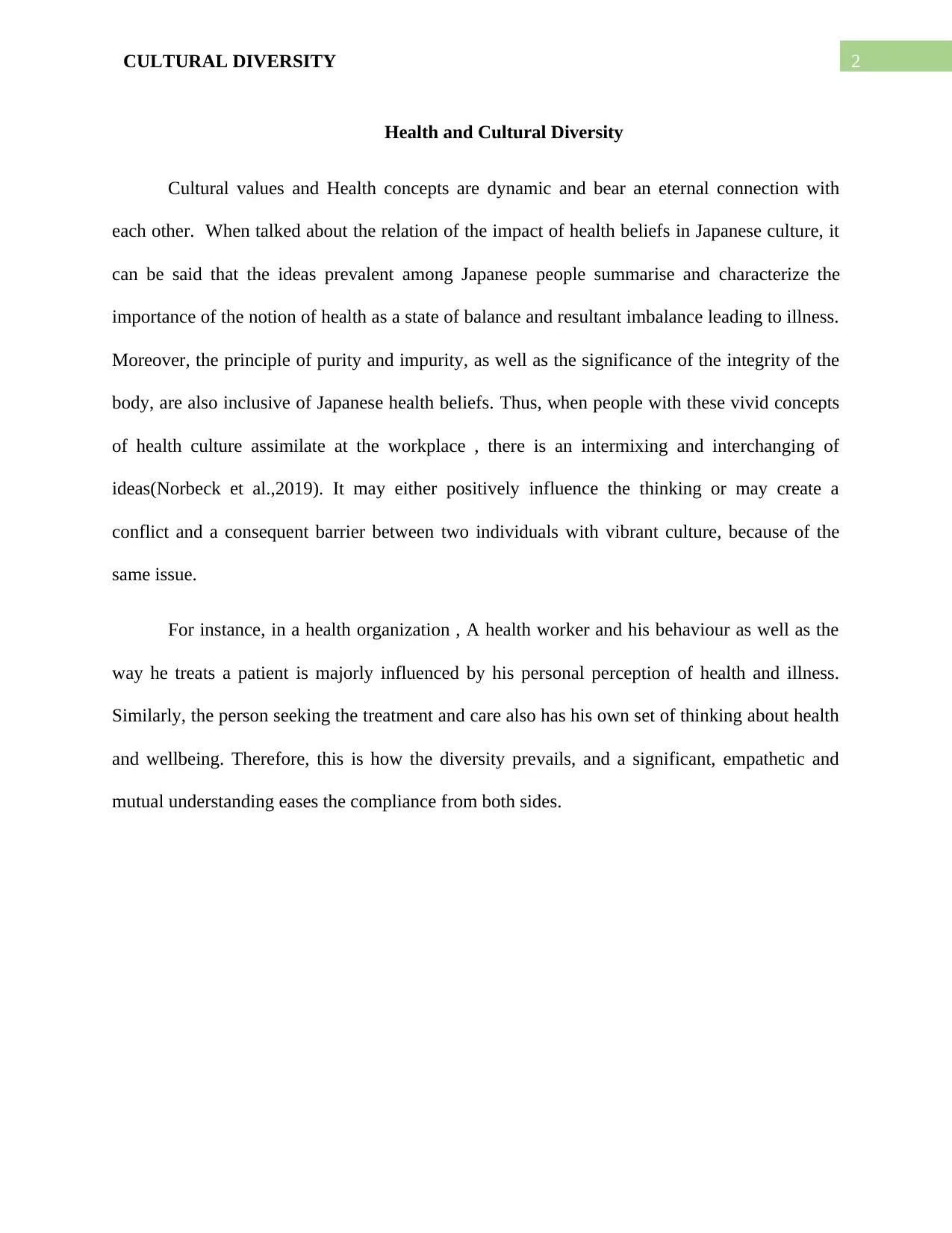
2CULTURAL DIVERSITY
Health and Cultural Diversity
Cultural values and Health concepts are dynamic and bear an eternal connection with
each other. When talked about the relation of the impact of health beliefs in Japanese culture, it
can be said that the ideas prevalent among Japanese people summarise and characterize the
importance of the notion of health as a state of balance and resultant imbalance leading to illness.
Moreover, the principle of purity and impurity, as well as the significance of the integrity of the
body, are also inclusive of Japanese health beliefs. Thus, when people with these vivid concepts
of health culture assimilate at the workplace , there is an intermixing and interchanging of
ideas(Norbeck et al.,2019). It may either positively influence the thinking or may create a
conflict and a consequent barrier between two individuals with vibrant culture, because of the
same issue.
For instance, in a health organization , A health worker and his behaviour as well as the
way he treats a patient is majorly influenced by his personal perception of health and illness.
Similarly, the person seeking the treatment and care also has his own set of thinking about health
and wellbeing. Therefore, this is how the diversity prevails, and a significant, empathetic and
mutual understanding eases the compliance from both sides.
Health and Cultural Diversity
Cultural values and Health concepts are dynamic and bear an eternal connection with
each other. When talked about the relation of the impact of health beliefs in Japanese culture, it
can be said that the ideas prevalent among Japanese people summarise and characterize the
importance of the notion of health as a state of balance and resultant imbalance leading to illness.
Moreover, the principle of purity and impurity, as well as the significance of the integrity of the
body, are also inclusive of Japanese health beliefs. Thus, when people with these vivid concepts
of health culture assimilate at the workplace , there is an intermixing and interchanging of
ideas(Norbeck et al.,2019). It may either positively influence the thinking or may create a
conflict and a consequent barrier between two individuals with vibrant culture, because of the
same issue.
For instance, in a health organization , A health worker and his behaviour as well as the
way he treats a patient is majorly influenced by his personal perception of health and illness.
Similarly, the person seeking the treatment and care also has his own set of thinking about health
and wellbeing. Therefore, this is how the diversity prevails, and a significant, empathetic and
mutual understanding eases the compliance from both sides.
⊘ This is a preview!⊘
Do you want full access?
Subscribe today to unlock all pages.

Trusted by 1+ million students worldwide
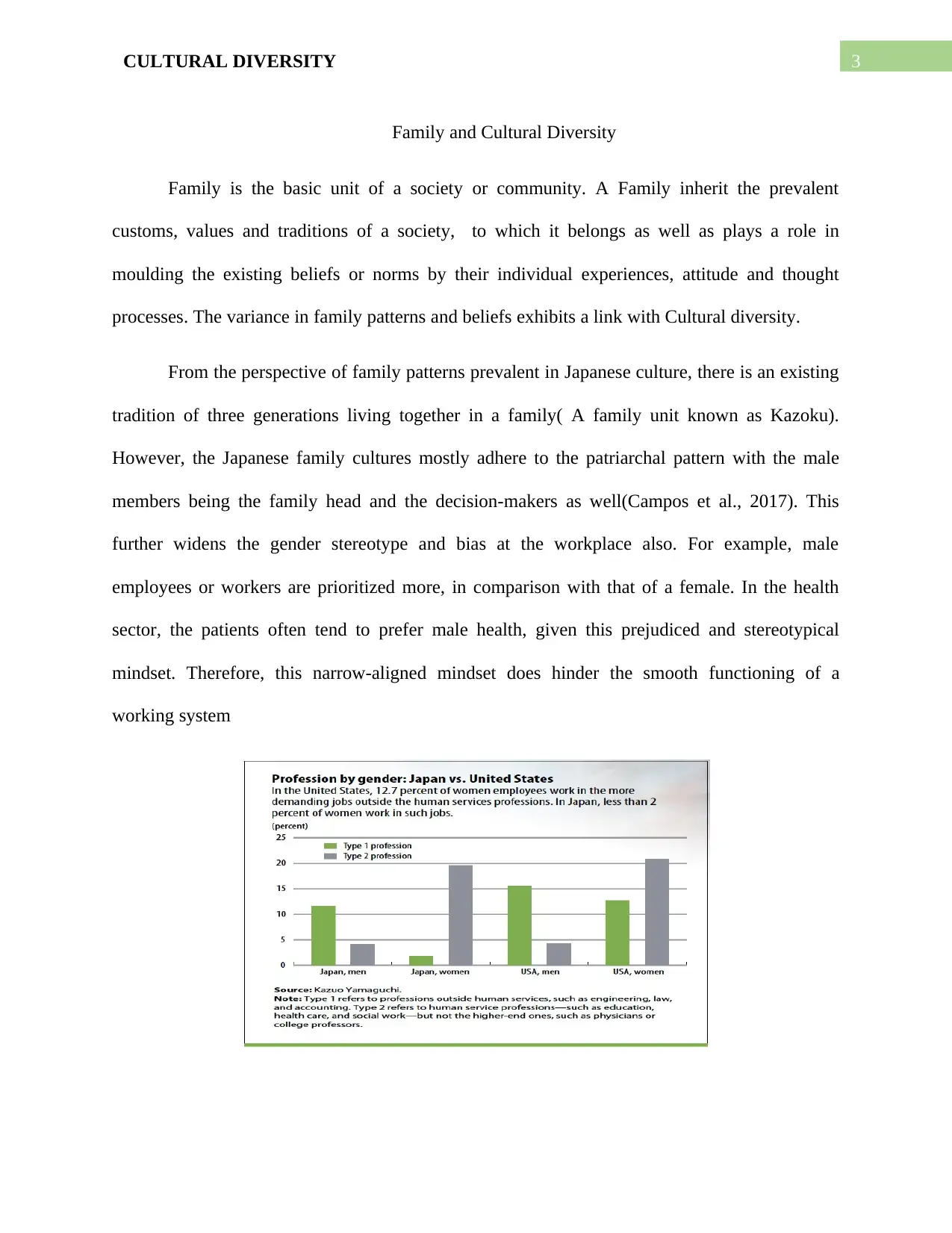
3CULTURAL DIVERSITY
Family and Cultural Diversity
Family is the basic unit of a society or community. A Family inherit the prevalent
customs, values and traditions of a society, to which it belongs as well as plays a role in
moulding the existing beliefs or norms by their individual experiences, attitude and thought
processes. The variance in family patterns and beliefs exhibits a link with Cultural diversity.
From the perspective of family patterns prevalent in Japanese culture, there is an existing
tradition of three generations living together in a family( A family unit known as Kazoku).
However, the Japanese family cultures mostly adhere to the patriarchal pattern with the male
members being the family head and the decision-makers as well(Campos et al., 2017). This
further widens the gender stereotype and bias at the workplace also. For example, male
employees or workers are prioritized more, in comparison with that of a female. In the health
sector, the patients often tend to prefer male health, given this prejudiced and stereotypical
mindset. Therefore, this narrow-aligned mindset does hinder the smooth functioning of a
working system
Family and Cultural Diversity
Family is the basic unit of a society or community. A Family inherit the prevalent
customs, values and traditions of a society, to which it belongs as well as plays a role in
moulding the existing beliefs or norms by their individual experiences, attitude and thought
processes. The variance in family patterns and beliefs exhibits a link with Cultural diversity.
From the perspective of family patterns prevalent in Japanese culture, there is an existing
tradition of three generations living together in a family( A family unit known as Kazoku).
However, the Japanese family cultures mostly adhere to the patriarchal pattern with the male
members being the family head and the decision-makers as well(Campos et al., 2017). This
further widens the gender stereotype and bias at the workplace also. For example, male
employees or workers are prioritized more, in comparison with that of a female. In the health
sector, the patients often tend to prefer male health, given this prejudiced and stereotypical
mindset. Therefore, this narrow-aligned mindset does hinder the smooth functioning of a
working system
Paraphrase This Document
Need a fresh take? Get an instant paraphrase of this document with our AI Paraphraser

4CULTURAL DIVERSITY
Figure 1: A statistical representation of the effect of gender diversity in varied professions in
Japan (Japan’s Gender Gap – IMF Finance & Development Magazine | March 2, 2020)
Figure 1: A statistical representation of the effect of gender diversity in varied professions in
Japan (Japan’s Gender Gap – IMF Finance & Development Magazine | March 2, 2020)
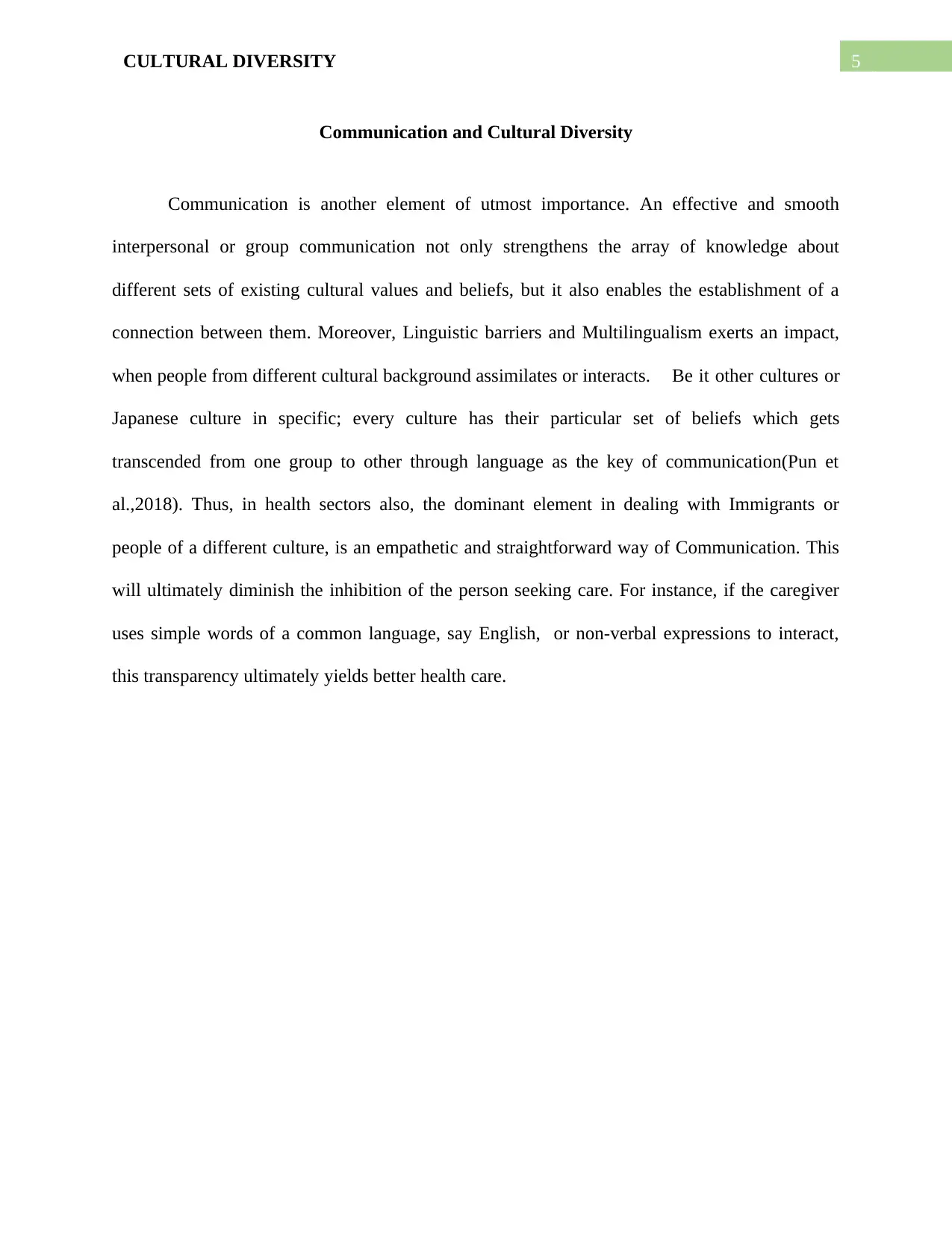
5CULTURAL DIVERSITY
Communication and Cultural Diversity
Communication is another element of utmost importance. An effective and smooth
interpersonal or group communication not only strengthens the array of knowledge about
different sets of existing cultural values and beliefs, but it also enables the establishment of a
connection between them. Moreover, Linguistic barriers and Multilingualism exerts an impact,
when people from different cultural background assimilates or interacts. Be it other cultures or
Japanese culture in specific; every culture has their particular set of beliefs which gets
transcended from one group to other through language as the key of communication(Pun et
al.,2018). Thus, in health sectors also, the dominant element in dealing with Immigrants or
people of a different culture, is an empathetic and straightforward way of Communication. This
will ultimately diminish the inhibition of the person seeking care. For instance, if the caregiver
uses simple words of a common language, say English, or non-verbal expressions to interact,
this transparency ultimately yields better health care.
Communication and Cultural Diversity
Communication is another element of utmost importance. An effective and smooth
interpersonal or group communication not only strengthens the array of knowledge about
different sets of existing cultural values and beliefs, but it also enables the establishment of a
connection between them. Moreover, Linguistic barriers and Multilingualism exerts an impact,
when people from different cultural background assimilates or interacts. Be it other cultures or
Japanese culture in specific; every culture has their particular set of beliefs which gets
transcended from one group to other through language as the key of communication(Pun et
al.,2018). Thus, in health sectors also, the dominant element in dealing with Immigrants or
people of a different culture, is an empathetic and straightforward way of Communication. This
will ultimately diminish the inhibition of the person seeking care. For instance, if the caregiver
uses simple words of a common language, say English, or non-verbal expressions to interact,
this transparency ultimately yields better health care.
⊘ This is a preview!⊘
Do you want full access?
Subscribe today to unlock all pages.

Trusted by 1+ million students worldwide
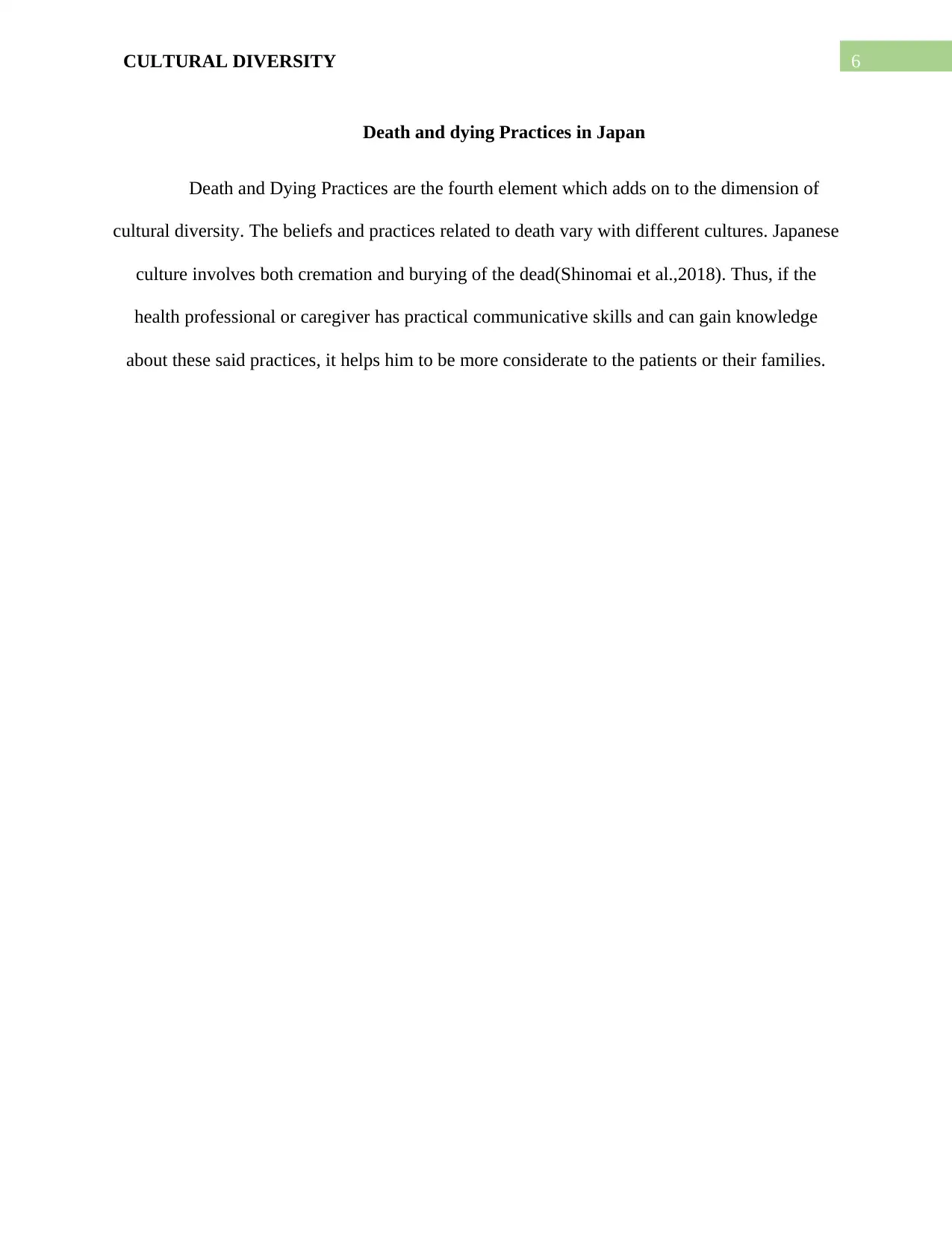
6CULTURAL DIVERSITY
Death and dying Practices in Japan
Death and Dying Practices are the fourth element which adds on to the dimension of
cultural diversity. The beliefs and practices related to death vary with different cultures. Japanese
culture involves both cremation and burying of the dead(Shinomai et al.,2018). Thus, if the
health professional or caregiver has practical communicative skills and can gain knowledge
about these said practices, it helps him to be more considerate to the patients or their families.
Death and dying Practices in Japan
Death and Dying Practices are the fourth element which adds on to the dimension of
cultural diversity. The beliefs and practices related to death vary with different cultures. Japanese
culture involves both cremation and burying of the dead(Shinomai et al.,2018). Thus, if the
health professional or caregiver has practical communicative skills and can gain knowledge
about these said practices, it helps him to be more considerate to the patients or their families.
Paraphrase This Document
Need a fresh take? Get an instant paraphrase of this document with our AI Paraphraser
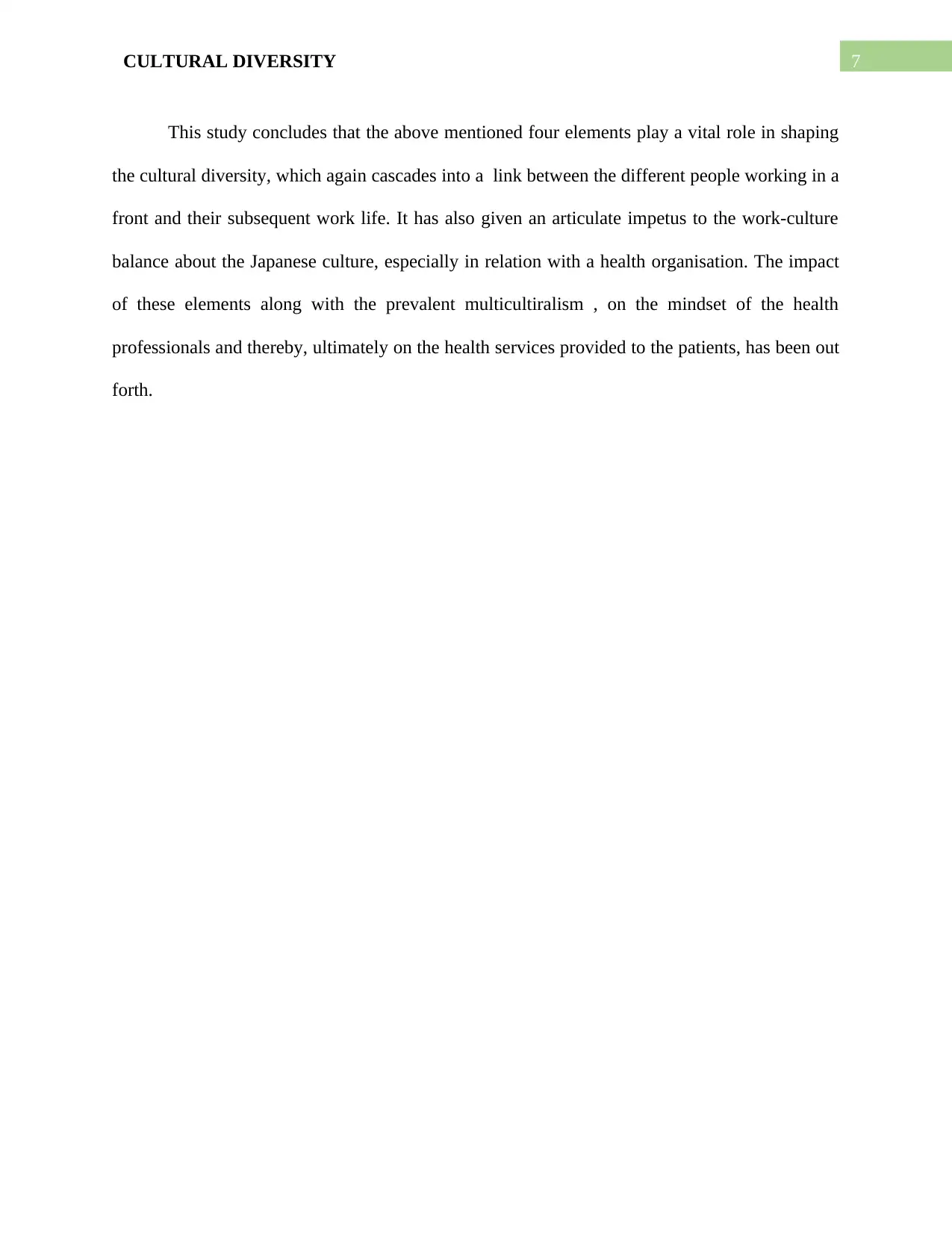
7CULTURAL DIVERSITY
This study concludes that the above mentioned four elements play a vital role in shaping
the cultural diversity, which again cascades into a link between the different people working in a
front and their subsequent work life. It has also given an articulate impetus to the work-culture
balance about the Japanese culture, especially in relation with a health organisation. The impact
of these elements along with the prevalent multicultiralism , on the mindset of the health
professionals and thereby, ultimately on the health services provided to the patients, has been out
forth.
This study concludes that the above mentioned four elements play a vital role in shaping
the cultural diversity, which again cascades into a link between the different people working in a
front and their subsequent work life. It has also given an articulate impetus to the work-culture
balance about the Japanese culture, especially in relation with a health organisation. The impact
of these elements along with the prevalent multicultiralism , on the mindset of the health
professionals and thereby, ultimately on the health services provided to the patients, has been out
forth.
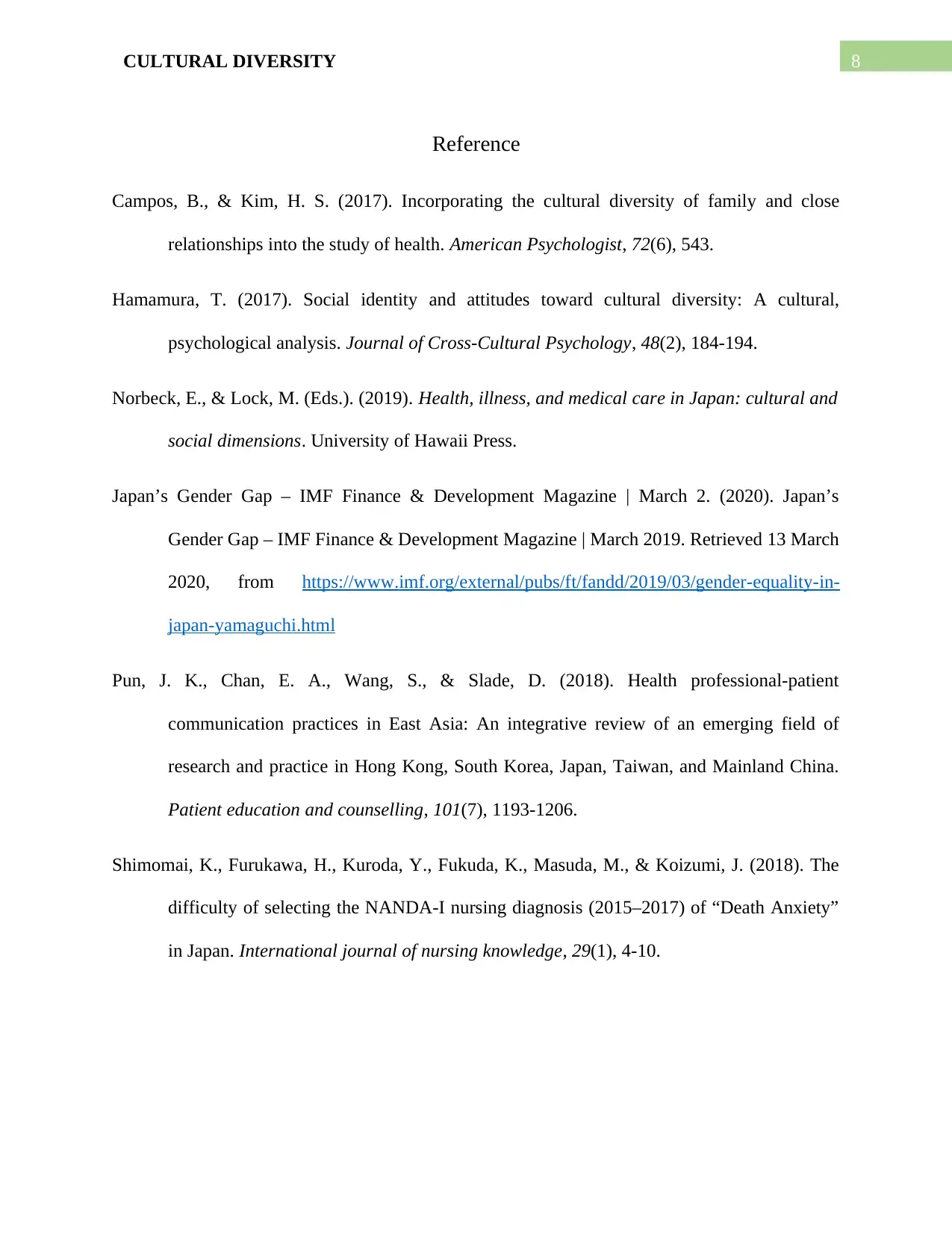
8CULTURAL DIVERSITY
Reference
Campos, B., & Kim, H. S. (2017). Incorporating the cultural diversity of family and close
relationships into the study of health. American Psychologist, 72(6), 543.
Hamamura, T. (2017). Social identity and attitudes toward cultural diversity: A cultural,
psychological analysis. Journal of Cross-Cultural Psychology, 48(2), 184-194.
Norbeck, E., & Lock, M. (Eds.). (2019). Health, illness, and medical care in Japan: cultural and
social dimensions. University of Hawaii Press.
Japan’s Gender Gap – IMF Finance & Development Magazine | March 2. (2020). Japan’s
Gender Gap – IMF Finance & Development Magazine | March 2019. Retrieved 13 March
2020, from https://www.imf.org/external/pubs/ft/fandd/2019/03/gender-equality-in-
japan-yamaguchi.html
Pun, J. K., Chan, E. A., Wang, S., & Slade, D. (2018). Health professional-patient
communication practices in East Asia: An integrative review of an emerging field of
research and practice in Hong Kong, South Korea, Japan, Taiwan, and Mainland China.
Patient education and counselling, 101(7), 1193-1206.
Shimomai, K., Furukawa, H., Kuroda, Y., Fukuda, K., Masuda, M., & Koizumi, J. (2018). The
difficulty of selecting the NANDA‐I nursing diagnosis (2015–2017) of “Death Anxiety”
in Japan. International journal of nursing knowledge, 29(1), 4-10.
Reference
Campos, B., & Kim, H. S. (2017). Incorporating the cultural diversity of family and close
relationships into the study of health. American Psychologist, 72(6), 543.
Hamamura, T. (2017). Social identity and attitudes toward cultural diversity: A cultural,
psychological analysis. Journal of Cross-Cultural Psychology, 48(2), 184-194.
Norbeck, E., & Lock, M. (Eds.). (2019). Health, illness, and medical care in Japan: cultural and
social dimensions. University of Hawaii Press.
Japan’s Gender Gap – IMF Finance & Development Magazine | March 2. (2020). Japan’s
Gender Gap – IMF Finance & Development Magazine | March 2019. Retrieved 13 March
2020, from https://www.imf.org/external/pubs/ft/fandd/2019/03/gender-equality-in-
japan-yamaguchi.html
Pun, J. K., Chan, E. A., Wang, S., & Slade, D. (2018). Health professional-patient
communication practices in East Asia: An integrative review of an emerging field of
research and practice in Hong Kong, South Korea, Japan, Taiwan, and Mainland China.
Patient education and counselling, 101(7), 1193-1206.
Shimomai, K., Furukawa, H., Kuroda, Y., Fukuda, K., Masuda, M., & Koizumi, J. (2018). The
difficulty of selecting the NANDA‐I nursing diagnosis (2015–2017) of “Death Anxiety”
in Japan. International journal of nursing knowledge, 29(1), 4-10.
⊘ This is a preview!⊘
Do you want full access?
Subscribe today to unlock all pages.

Trusted by 1+ million students worldwide
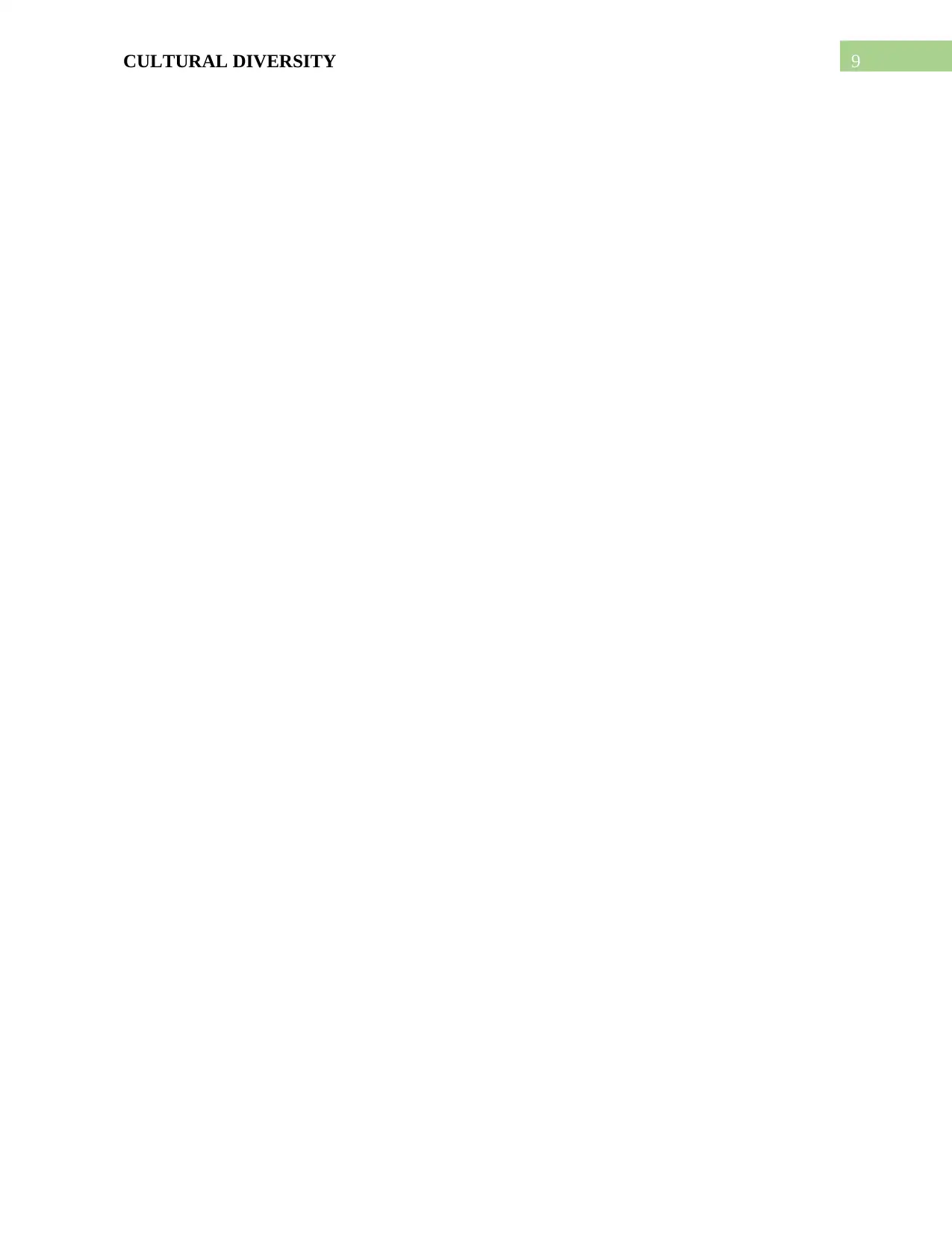
9CULTURAL DIVERSITY
1 out of 10
Related Documents
Your All-in-One AI-Powered Toolkit for Academic Success.
+13062052269
info@desklib.com
Available 24*7 on WhatsApp / Email
![[object Object]](/_next/static/media/star-bottom.7253800d.svg)
Unlock your academic potential
Copyright © 2020–2025 A2Z Services. All Rights Reserved. Developed and managed by ZUCOL.




